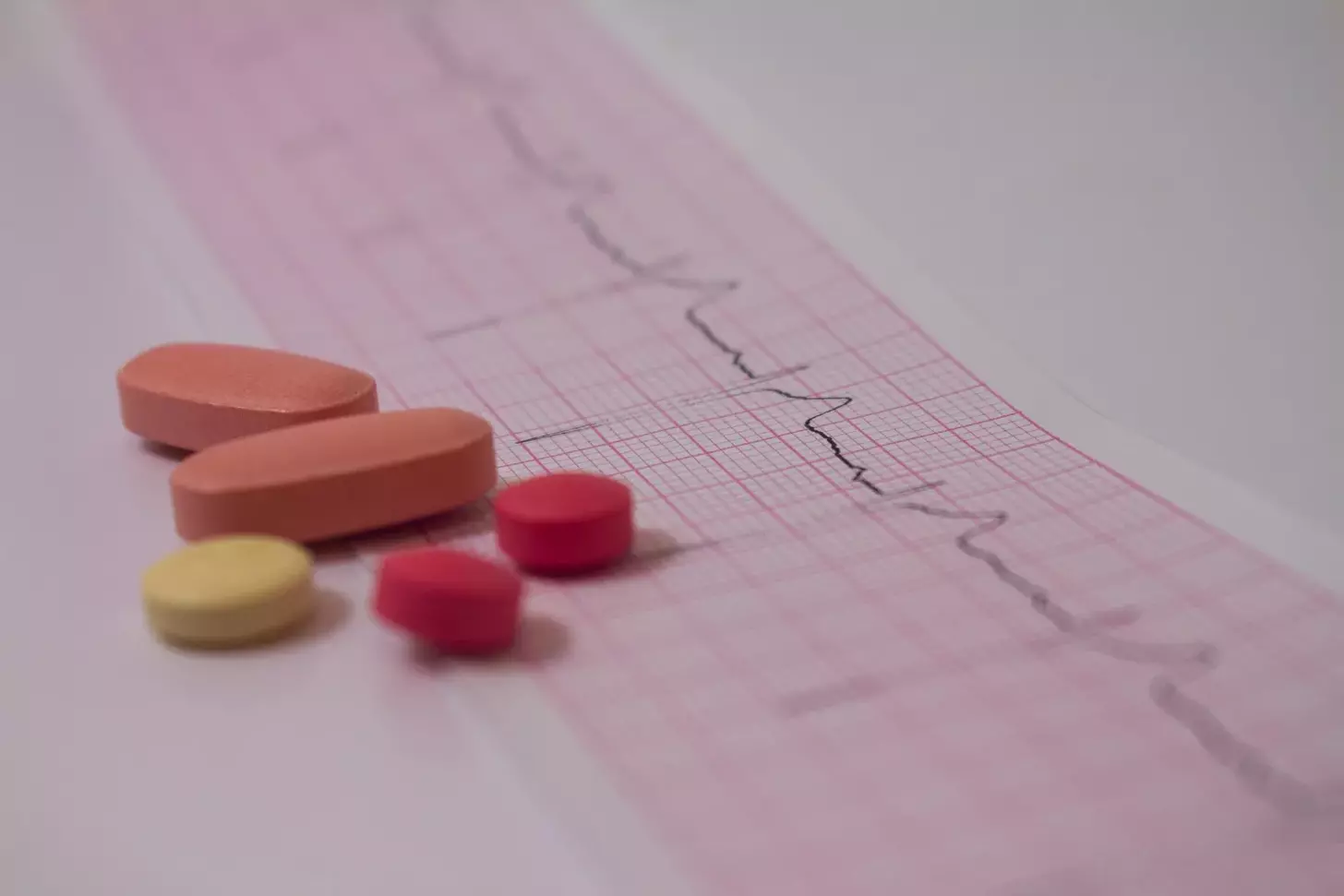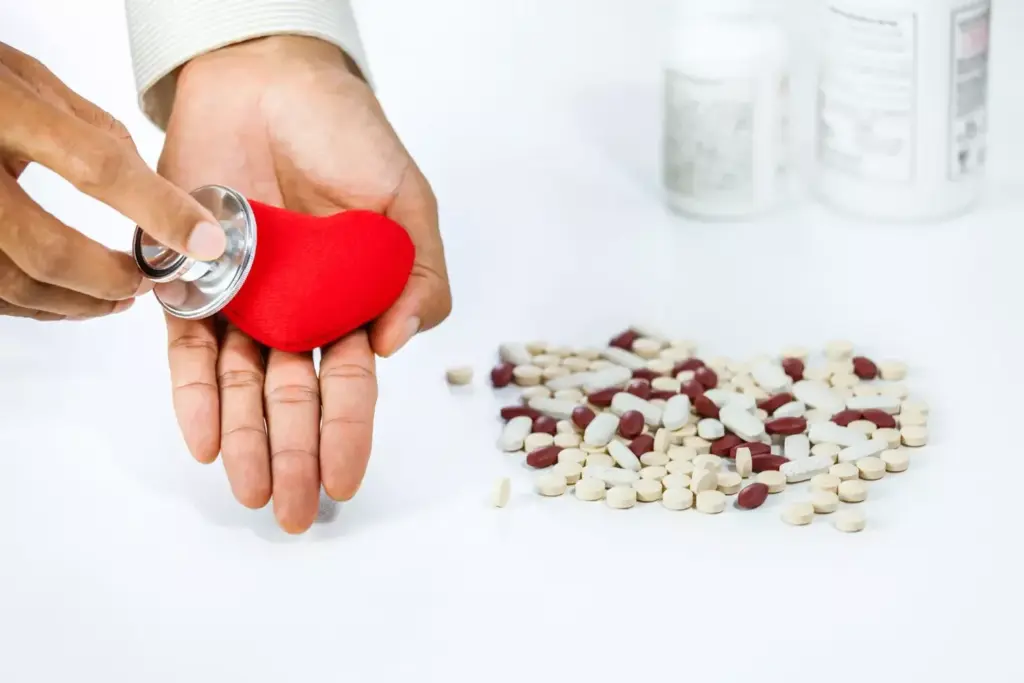Last Updated on November 4, 2025 by mcelik

When a heart attack strikes, every second counts, and choosing the right medication for myocardial infarction can save lives. At Liv Hospital, our trusted, innovative, and internationally respected medical team delivers optimal care from the first dose onward.
We understand that effective treatment is crucial in reducing mortality and preventing further cardiac damage. Medications such as aspirin, P2Y12 inhibitors, beta blockers, and ACE inhibitors play a vital role in managing myocardial infarction.
Our medical team is committed to providing world-class healthcare with comprehensive support for international patients. By understanding the essential acute myocardial infarction drugs, patients and healthcare providers can make informed decisions about care.

Understanding the mechanisms behind myocardial infarction is crucial for appreciating the importance of timely treatment. Myocardial infarction, commonly known as a heart attack, occurs when the blood flow to the heart is severely blocked, leading to damage or death of the heart muscle tissue.
The pathophysiology of myocardial infarction involves a complex interplay of factors leading to the occlusion of a coronary artery. This occlusion can result from the rupture of an atherosclerotic plaque, followed by the formation of a thrombus that blocks the artery. The blockage deprives the heart muscle of oxygen and nutrients, leading to ischemia and eventually infarction.
Key factors contributing to myocardial infarction include:
The concept of the “golden hour” is critical in the management of myocardial infarction. It refers to the first hour after the onset of symptoms, during which timely medical intervention can significantly improve outcomes. Studies have shown that early intervention within this period can reduce mortality and morbidity.
“Time is muscle” is a mantra in cardiology, emphasizing that the sooner the intervention, the more heart muscle can be saved.”
The primary goals of pharmacological intervention in myocardial infarction are to restore blood flow to the affected area, reduce the workload on the heart, and prevent further clot formation. We achieve these goals through the use of various medications, including antiplatelet agents, anticoagulants, beta-blockers, and nitrates.
The timely administration of these drugs is crucial in improving survival and reducing the risk of complications. Our treatment protocols are designed to be initiated promptly upon diagnosis, with ongoing management tailored to the individual patient’s needs.
The key pharmacological interventions include:

The management of acute myocardial infarction (MI) involves a multifaceted approach that relies heavily on pharmacological interventions to improve survival rates. These interventions are critical in reducing mortality and enhancing the quality of life for MI patients.
Drugs used in the treatment of myocardial infarction work through various mechanisms to reduce mortality. Antiplatelet agents, such as aspirin, inhibit platelet aggregation, thereby preventing the formation of new clots and reducing the risk of further cardiac events. Beta-blockers decrease the workload on the heart, lowering the demand for oxygen and reducing the risk of arrhythmias. Statins, on the other hand, lower cholesterol levels, slowing the progression of atherosclerosis.
Research has shown that the timely administration of these drugs significantly improves outcomes for MI patients. For instance, dual antiplatelet therapy has been proven to reduce the incidence of stent thrombosis in patients undergoing percutaneous coronary intervention (PCI).
Immediate treatment strategies for MI focus on restoring blood flow to the affected myocardium and preventing further clot formation. This is achieved through the administration of antiplatelet agents, anticoagulants, and thrombolytics, if appropriate. Long-term strategies, however, aim at managing risk factors, preventing recurrent cardiac events, and improving overall cardiovascular health.
Long-term management may include the continued use of beta-blockers, ACE inhibitors, and statins, alongside lifestyle modifications such as diet, exercise, and smoking cessation. The choice of medication and treatment strategy is tailored to the individual patient’s needs and risk profile.
Evidence-based medication protocols guide the use of MI drugs, ensuring that patients receive the most effective treatment. Guidelines recommend the use of dual antiplatelet therapy for at least 12 months following PCI, with aspirin continued indefinitely. Statins are recommended for all MI patients, with high-intensity statin therapy preferred for those at higher risk.
| Drug Class | Mechanism of Action | Impact on Survival |
|---|---|---|
| Antiplatelet Agents | Inhibit platelet aggregation | Reduces clot formation, lowers risk of further cardiac events |
| Beta-Blockers | Decreases cardiac workload, lowers oxygen demand | Reduces risk of arrhythmias, improves survival |
| Statins | Lowers cholesterol levels | Slows progression of atherosclerosis, reduces cardiac events |
As a cornerstone in the management of myocardial infarction, aspirin works by irreversibly inhibiting cyclooxygenase-1, thereby reducing thromboxane A2 production. This mechanism is crucial in the immediate treatment of MI, as it significantly reduces the risk of further cardiac damage.
Aspirin’s antiplatelet effect is primarily due to its ability to inhibit the enzyme cyclooxygenase-1 (COX-1), which is necessary for the production of thromboxane A2, a potent platelet activator. By irreversibly acetylating COX-1, aspirin prevents the synthesis of thromboxane A2, thereby inhibiting platelet aggregation and clot formation.
Key aspects of aspirin’s mechanism include:
In emergency settings, a loading dose of aspirin is administered to rapidly achieve therapeutic levels. The typical loading dose ranges from 162 mg to 325 mg. The choice of dose may depend on the patient’s previous aspirin use and the specific clinical scenario.
The goal of the loading dose is to quickly inhibit platelet function, thereby reducing the risk of further clot formation and cardiac damage.
Following the initial loading dose, long-term maintenance therapy with aspirin is crucial for preventing recurrent cardiac events. The maintenance dose typically ranges from 81 mg to 162 mg daily.
Benefits of long-term aspirin therapy include:
While aspirin is generally well-tolerated, there are contraindications and potential side effects to be aware of. Contraindications include active bleeding, known aspirin allergy, and severe renal impairment.
Common side effects and their management:
| Side Effect | Management Strategy |
|---|---|
| Gastrointestinal bleeding | Proton pump inhibitors, consider alternative antiplatelet therapy |
| Aspirin intolerance | Desensitization protocols or alternative antiplatelet agents |
Advanced antiplatelet therapy with P2Y12 inhibitors plays a crucial role in improving outcomes for patients with myocardial infarction. These drugs, when used in combination with aspirin, constitute dual antiplatelet therapy (DAPT), a cornerstone in the management of acute myocardial infarction.
P2Y12 inhibitors, including clopidogrel, ticagrelor, and prasugrel, have distinct characteristics that influence their use in clinical practice. Ticagrelor and prasugrel have a more rapid onset of action compared to clopidogrel, which is significant in the acute setting.
The choice and loading dose of P2Y12 inhibitors are critical in the acute management of myocardial infarction. Loading doses are used to achieve rapid platelet inhibition.
The duration of DAPT must be balanced between the benefits of reduced ischemic events and the risks of increased bleeding. Guidelines recommend at least 12 months of DAPT after acute myocardial infarction, but this can be tailored based on patient risk factors and bleeding risk.
“The optimal duration of DAPT should be individualized, taking into account the patient’s ischemic and bleeding risks.”
— ESC Guidelines
Switching between P2Y12 inhibitors may be considered in specific clinical scenarios, such as side effects or inadequate platelet inhibition. Careful consideration of the patient’s clinical status and the pharmacological properties of the drugs is necessary when switching.
We recommend a personalized approach to using P2Y12 inhibitors, considering the unique characteristics of each drug and the individual patient’s needs.
Managing acute myocardial infarction effectively requires the use of anticoagulants. Anticoagulants are crucial in preventing the growth of existing clots and the formation of new ones, thereby reducing the risk of further cardiac damage.
We use both unfractionated heparin (UFH) and low molecular weight heparins (LMWH) in the management of acute MI. UFH has been the traditional choice, offering the advantage of easy reversibility with protamine sulfate. However, LMWH has gained popularity due to its more predictable anticoagulation profile, reduced need for monitoring, and lower risk of heparin-induced thrombocytopenia.
Key differences between UFH and LMWH:
Direct oral anticoagulants (DOACs) have emerged as an alternative to traditional anticoagulants in specific scenarios. We consider DOACs for patients with atrial fibrillation or those requiring anticoagulation for other indications post-MI.
The choice between DOACs and traditional anticoagulants depends on individual patient factors.
One of the critical challenges in using anticoagulants in acute MI management is balancing the risk of bleeding against the antithrombotic benefits. We carefully assess each patient’s risk factors for bleeding and adjust our anticoagulation strategy accordingly.
| Risk Factor | Bleeding Risk | Antithrombotic Benefit |
|---|---|---|
| Age >75 | High | Moderate |
| Renal Impairment | High | Low |
| History of Bleeding | Very High | Low |
Transitioning from parenteral anticoagulants to oral anticoagulation is a critical step in the management of acute MI. We ensure a smooth transition by carefully planning the overlap of parenteral and oral anticoagulants to maintain adequate anticoagulation coverage.
Key considerations for transitioning:
We utilize beta blockers to decrease the heart’s workload and improve outcomes in myocardial infarction patients. Beta blockers have been a cornerstone in the management of myocardial infarction, acting to reduce cardiac workload and oxygen demand, thereby limiting infarct size and improving survival.
The timing of beta blocker administration can vary between ST-elevation myocardial infarction (STEMI) and non-ST-elevation myocardial infarction (NSTEMI). In STEMI, early administration of beta blockers is recommended, particularly in the acute phase, to reduce mortality and morbidity. For NSTEMI, beta blockers are also recommended early in the course of treatment, unless contraindicated.
Key considerations for beta blocker administration include:
Beta blockers exert their cardioprotective effects through several mechanisms, including reducing heart rate, contractility, and blood pressure. By decreasing the heart’s workload, beta blockers help preserve cardiac function and reduce the risk of further damage.
The cardioprotective effects of beta blockers are multifaceted:
Long-term use of beta blockers in post-myocardial infarction patients has been shown to reduce the risk of recurrent events and improve survival. The benefits of beta blockers extend beyond the acute phase, providing ongoing protection against cardiovascular events.
“Beta blockers have been shown to reduce mortality and improve outcomes in patients with myocardial infarction.”
Patient selection is crucial when considering beta blocker therapy. Certain contraindications, such as significant bradycardia, heart failure, or severe peripheral artery disease, must be carefully evaluated. Healthcare providers must weigh the benefits against the potential risks for each patient.
By understanding the role of beta blockers in myocardial infarction management, healthcare providers can optimize treatment strategies to improve patient outcomes.
Nitrates play a crucial role in managing myocardial infarction by alleviating ischemic symptoms. We utilize nitrates to provide immediate relief to patients suffering from acute myocardial infarction.
Nitrates work by releasing nitric oxide, which causes vasodilation and reduces preload, thereby decreasing myocardial oxygen demand. This mechanism is crucial for the immediate relief of ischemic symptoms in myocardial infarction patients.
The use of nitrates results in:
Nitrates can be administered through various routes, including sublingual, intravenous, and oral formulations. Each route has its specific indications and benefits.
Sublingual nitroglycerin is commonly used for immediate relief due to its rapid absorption.
Intravenous nitroglycerin is used in more severe cases, allowing for precise control over dosage.
While nitrates provide rapid relief, their use is limited by the development of tolerance with continuous administration. To mitigate this, we often implement nitrate-free intervals.
| Formulation | Administration Route | Onset of Action |
|---|---|---|
| Sublingual Nitroglycerin | Sublingual | 1-3 minutes |
| Intravenous Nitroglycerin | Intravenous | Immediate |
In the acute setting, nitrates are invaluable for managing pain and ischemia. However, their role in long-term care is more limited due to tolerance and potential side effects.
We recommend using nitrates judiciously, balancing their benefits against the risks, especially in long-term management.
Long-term cardioprotection following a myocardial infarction is significantly enhanced by the strategic use of ACE inhibitors, ARBs, and aldosterone antagonists. These medications have been shown to counteract the renin-angiotensin-aldosterone system (RAAS), thereby preventing adverse cardiac remodeling and improving survival rates in post-MI patients.
Adverse cardiac remodeling is a complex process involving changes in the size, shape, and function of the heart after an MI. ACE inhibitors and ARBs play a crucial role in mitigating this process by reducing the levels of angiotensin II, a potent vasoconstrictor that can lead to increased blood pressure and cardiac workload. By inhibiting the RAAS pathway, these medications help in preserving cardiac function and reducing the risk of heart failure.
The timing of initiation of ACE inhibitors, ARBs, and aldosterone antagonists after MI is critical. Early initiation of these medications in stable patients has been associated with improved outcomes. Clinical guidelines recommend starting these medications within the first 24-48 hours after MI, provided there are no contraindications. This early start helps in maximizing their cardioprotective benefits.
The use of ACE inhibitors and ARBs has been shown to improve ejection fraction and reduce the risk of heart failure in post-MI patients. By preventing adverse cardiac remodeling, these medications help in maintaining the heart’s pumping efficiency. Aldosterone antagonists further add to this benefit by reducing mortality and morbidity in patients with severe heart failure.
While ACE inhibitors, ARBs, and aldosterone antagonists offer significant cardioprotective benefits, their use requires careful monitoring of renal function and electrolytes. Regular monitoring of serum creatinine and potassium levels is essential to mitigate the risk of hyperkalemia and renal dysfunction. This monitoring ensures that the benefits of these medications are maximized while minimizing their potential side effects.
The use of statins in secondary prevention post-myocardial infarction has become a cornerstone in managing cardiovascular health. Statins are a group of cholesterol-lowering medications that have been shown to significantly reduce the risk of recurrent cardiovascular events in patients who have had a myocardial infarction. We will explore the benefits of high-intensity statin therapy, the importance of early initiation, target lipid levels, and additional lipid-lowering therapies.
High-intensity statin therapy is particularly effective in reducing low-density lipoprotein (LDL) cholesterol levels, a key factor in the development of atherosclerosis. Studies have demonstrated that high-intensity statin therapy can significantly reduce the risk of major vascular events compared to standard statin therapy. The benefits include:
Initiating statin therapy early during hospitalization for myocardial infarction has been shown to improve patient outcomes. Early initiation helps in quickly reducing LDL levels and stabilizing plaques, thereby reducing the risk of early recurrent events.
The goal of statin therapy is to achieve significantly reduced LDL levels. Guidelines recommend targeting LDL levels below 70 mg/dL or even lower in very high-risk patients. Regular monitoring of lipid profiles is essential for adjusting therapy as needed.
We recommend:
For patients who remain at high risk despite statin therapy, additional lipid-lowering therapies may be considered. These include ezetimibe and PCSK9 inhibitors, which can further reduce LDL levels and cardiovascular risk.
Effective management of myocardial infarction requires a comprehensive approach that includes both immediate and long-term pharmacological interventions. We have discussed various critical components of evidence-based care, including aspirin, P2Y12 inhibitors, beta blockers, nitrates, ACE inhibitors, ARBs, aldosterone antagonists, and statins.
Integrating these therapies requires a thorough understanding of their mechanisms, benefits, and potential side effects. By understanding the role of each drug class and how they are used in different clinical scenarios, healthcare providers can optimize myocardial infarction treatment, improving both short-term and long-term outcomes. This integrated approach to mi drug therapy is crucial for providing high-quality long-term care.
We emphasize the importance of a tailored treatment plan that addresses the individual needs of patients, ensuring the best possible outcomes. By combining immediate and long-term drug therapy, we can significantly improve patient care and reduce the risk of future cardiovascular events.
The primary goal is to restore blood flow, reduce cardiac workload, and prevent further clot formation, thereby improving survival and outcomes.
Aspirin inhibits platelet aggregation by irreversibly inhibiting cyclooxygenase-1, preventing the production of thromboxane A2, a potent platelet activator, thereby reducing clot formation.
P2Y12 inhibitors, such as clopidogrel, ticagrelor, and prasugrel, are antiplatelet drugs used in combination with aspirin as dual antiplatelet therapy to prevent ischemic events.
Anticoagulants, such as unfractionated heparin and low molecular weight heparins, prevent the growth of existing clots and the formation of new ones, thereby reducing the risk of further cardiac events.
Beta blockers reduce cardiac workload and oxygen demand, limiting infarct size and improving survival by reducing heart rate, contractility, and blood pressure.
Nitrates release nitric oxide, causing vasodilation and reducing preload, thereby decreasing myocardial oxygen demand. However, their use is limited by the development of tolerance with continuous administration.
These drugs counteract the renin-angiotensin-aldosterone system, preventing adverse cardiac remodeling and improving survival, thereby reducing the risk of heart failure.
High-intensity statin therapy reduces low-density lipoprotein (LDL) cholesterol levels, a key factor in the development of atherosclerosis, thereby improving outcomes.
Early initiation of statins has been shown to improve outcomes by significantly reducing LDL levels, and monitoring lipid profiles is essential for adjusting therapy.
Long-term management involves a combination of medications, including aspirin, P2Y12 inhibitors, beta blockers, ACE inhibitors, ARBs, aldosterone antagonists, and statins, to prevent recurrent cardiac events and manage risk factors.
References
NHS. (n.d.). Diagnosing a heart attack. Retrieved from https://www.nhs.uk/conditions/heart-attack/diagnosis/
AAFP. (2017). Acute Coronary Syndrome: Diagnostic Evaluation. Retrieved from https://www.aafp.org/pubs/afp/issues/2017/0201/p170.html
American Heart Association. (n.d.). Diagnosing a Heart Attack. Retrieved from https://www.heart.org/en/health-topics/heart-attack/diagnosing-a-heart-attack
PMC. (2023). Understanding Myocardial Infarction. Retrieved from https://pmc.ncbi.nlm.nih.gov/articles/PMC9463516/.
Subscribe to our e-newsletter to stay informed about the latest innovations in the world of health and exclusive offers!
WhatsApp us